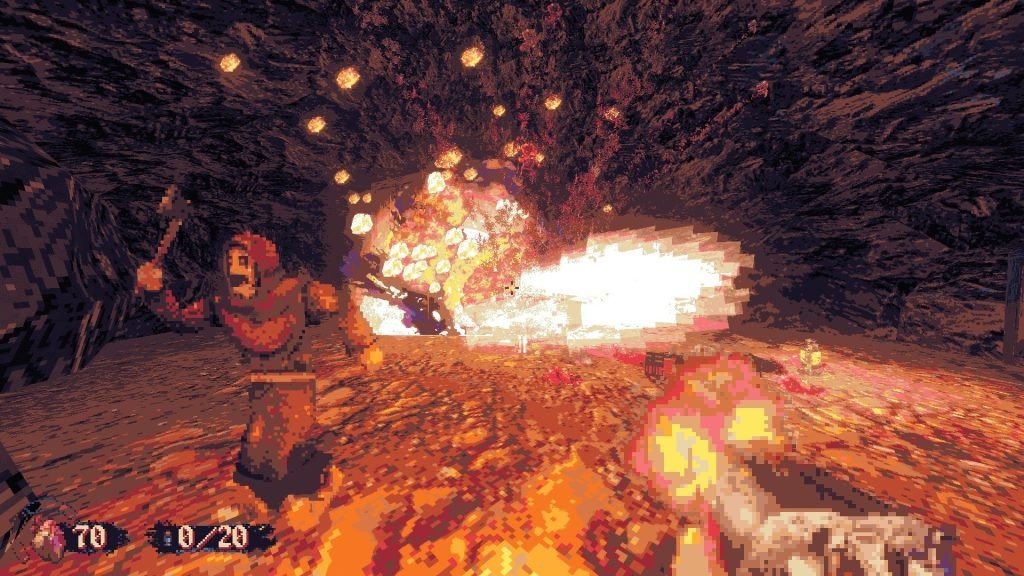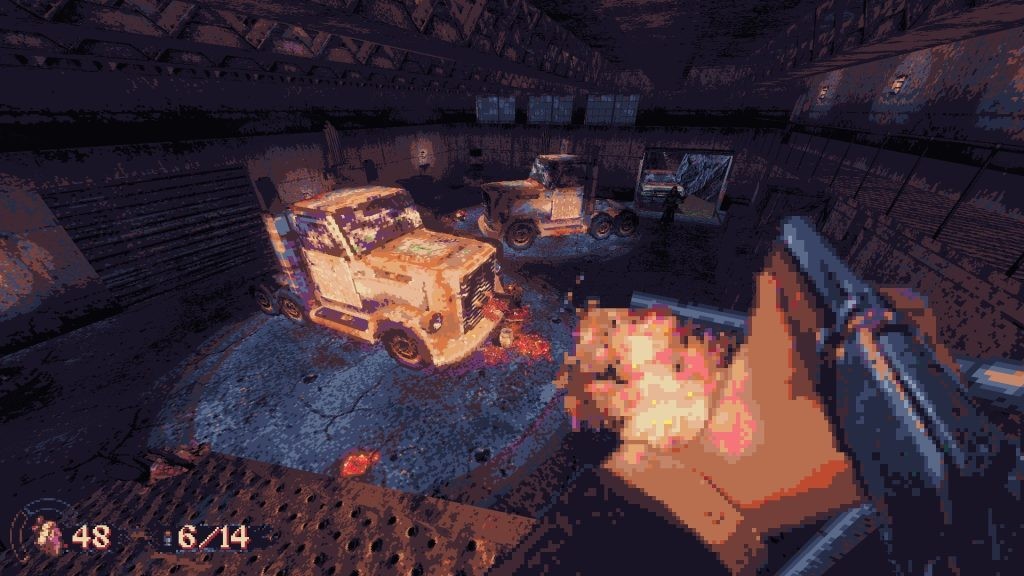Jason Smith of Jasozz Games released Cultic: Chapter One in October of this year. We reviewed the game for FandomWire and absolutely loved the retro aesthetic and crunchingly satisfying feel of the gameplay. A month following the game’s release, Jason sat down with us to chat about how the process of creating Cultic as a solo developer:
Hey Jason, thank you the taking the time to speak with us. Would you mind starting off by telling us a bit about yourself, your educational background and your career?

“I’ve been gaming as long as I can remember! Some of my earliest memories are fumbling through Super Metroid and Link to the Past on the family’s Super Nintendo and playing Dark Forces on my dad’s computer. My all-time favourites would definitely include Super Metroid, Resident Evil 4, and Dead Space. More recently, I’ve been super engrossed in Phasmophobia as well and it’s quickly become one of my favourites as well.”
Cultic: Chapter One is the first full game that you have released. You were also the sole developer on the game. Can you give us any insight into what it was like developing a game by yourself?
“Being a solo developer certainly comes with its share of challenges. You really have to pick your battles and fight feature creep with every bone in your body. A good example is deciding how deep I wanted to go when decorating environments. Sure, I could spend weeks modeling tons of unique little props and working up textures and decals to have each room be densely decorated… but is that worth the time that could be spent refining systems and working on building maps? No amount of work I do at my level is going to stack up against the kind of environment design seen in AAA games, and won’t ever be the standout feature of my game, so instead, I’ll focus my time on the things that will stand out – the gunplay, the visual stylization, the soundtrack, etc.”

“On the flip side of the challenges, and the main reason I prefer to work by myself, is the total freedom it affords. I don’t have to argue my ideas with anyone or sit in meetings to determine how a social media post will be handled, or delegate tasks out and then wait for them to be done. I just… do stuff – and that’s great. If I need a social media post, I just knock it out. If I see a bug that needs fixed, I just fix it. If I have a fun new idea for a mechanic, I just sit down and prototype it. It lets me keep the game focused and consistent and keeps anyone else from being subjected to my chaotic development process.”
Out of the things you have worked on throughout your career up until this point, what elements were most fundamental to Cultic’s development?
“Most of my skills when it comes to game development (modelling, texturing, audio design, etc. etc.) have just been slowly picked up over time, and in fact have been skills I’ve developed exponentially with being full-time. However, my previous experience as a graphic designer has been probably the most valuable skill to bring to the table from outside of game dev, as it lets me handle pretty much all of my own marketing. I do my own graphics, logos, merchandise, and whatever other marketing materials need made. I record and edit my own footage and edit my own videos. I write my own social media posts, do my own devlogs, etc. That all really helps me to be able to keep a “personal” touch on everything about CULTIC and keeps my finger firmly on the pulse of the community as well.”
What were your main influences when it came to creating Cultic?
“The Dark Forces II angle comes from the verticality of the environments and how free you are to explore them. The inclusion of the Force Speed and Force Jump abilities means that they really had to open up the environments, and just being able to kind of jump anywhere and go anywhere and use the Force powers to skip elevators and platforming was always really cool to me.”
Do you have any favourite moments from developing Cultic, or any particular point which you think back on fondly?
“CULTIC’s visual style just started out as just a little test to see if I could convert 3D models into sprites in a way that was visually pleasing, and without having to spend a ton of time doing clean-up. Basically, it needed to be a workflow that was manageable for a solo developer. Part of that process was trying to see if I could emulate the limited color palette that gave some of those older games their distinctive look. I had recently seen some footage of POOM, the PICO-8 DOOM “port”, and I was really impressed by how they managed to keep DOOM’s distinctive moody look, but with using PICO-8s very vibrant palette, so I wanted to do the same – basically create a grimy horror setting but using a limited palette with vibrant highlights. The initial results from testing this out looked pretty nice, so I posted them on Twitter, and they took off immediately – so I knew I was on the right track!”

What about the game’s audio?
“Designing CULTIC’s audio came from a place of wanting to emulate the crunchy, crusty bit-crushed sound of the audio in Duke 3D, but without sacrificing the clarity of the sounds. The issue with bitcrushing is that the low and high-end frequencies just get absolutely mangled by it, so using it as a blanket effect wasn’t going to work. This kind of guided the design of CULTIC’s “selective bitcrushing” where you’ve got a base layer of bitcrushed sound, with less processed audio then mixed in to make sure the sound is still distinct and impactful. For example, the music is mostly comprised of a custom soundfont that has bitcrushed instruments, but then one or two high-fidelity instruments will be added in, like the piano in E1M1. This gives the music a distinct sound, but that isn’t just the sound of a music track that was bitcrushed.”
Which parts of the game development process have you learned from the most? Anything which will affect how you approach development of Chapter Two?
“I would say that level design is definitely the part of the process that I struggled with the most and had to learn the most about. All of my previous projects have basically either been small gameplay prototypes that never made it to level design or were single screen arcadey games or procedurally generated. I had basically zero experience making full maps, guiding the player in subtle ways, making areas that are open enough to explore but not get lost in, and so on. Even just comparing the original CULTIC demo to the Next Fest demo you can see how much my map design changed and improved in some respects and faltered in others. It’s been a huge learning experience, and I feel like by the end of the episode I was finally starting to find good footing and a good balance for the map design. I hope to take this into Chapter Two by really focusing hard on making some standout maps.”
Also read: Ana de Armas Talks ‘Blonde’ In CCA Exclusive Conversation
3D Realms published Cultic. What incited the partnership with them?
“I can’t really say for sure what it was about CULTIC that drew their attention. When 3D Realms reached out, CULTIC was still basically just a small dirt test area and one really primitive enemy. The only thing it had going for it at that time was the crunchy aesthetic, as the visuals and audio were already on display. Whatever it was, it got them to reach out, and I quickly assembled a proof-of-concept demo to send over and show what kind of gameplay I was shooting (hah) for. They liked the demo, and I went full speed ahead on developing the first Realm’s Deep demo! That demo was received very warmly, and the traction the game was getting kind of showed 3D Realms and I that the game needed to be in full-time development, not just being done in my spare time.”
What are your ambitions for Cultic and for Jasozz Games going forward?
“CULTIC is going to be my life for another year or two I imagine, so I haven’t thought much about what I want to do after. I have a pile of design docs for games that I’d love to hop on and try developing, but they need to stay just as ideas for now. Chapter Two, localization, and console ports are all still monumental tasks that I need to tackle before I can think of moving on to another project. The dream though is just to be successful enough that I can keep doing this full-time! That’s all I’m really concerned with.”
Also read: Emily The Criminal Director, John Patton Ford, Interview (EXCLUSIVE)
Finally, can you tell us about anything about Cultic: Chapter Two?









![Lies of P's Game Director Jiwon Choi Discusses the Game, Disney and the Darker Sides of Pinocchio [EXCLUSIVE]](https://fwmedia.fandomwire.com/wp-content/uploads/2023/09/16134750/lies-1-768x432.png)




